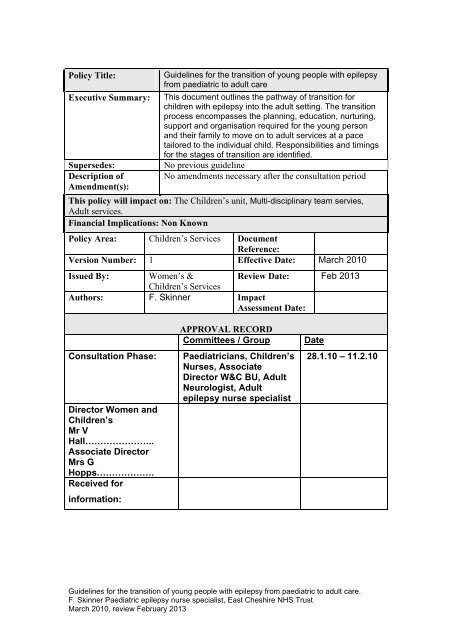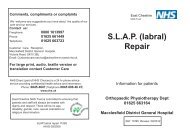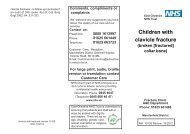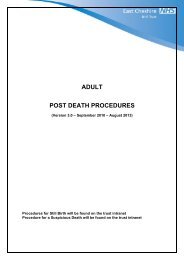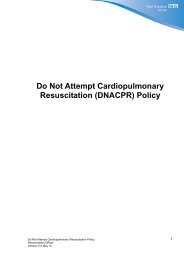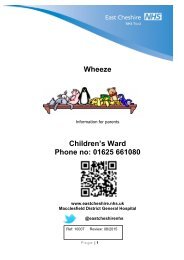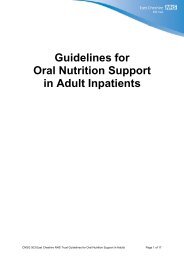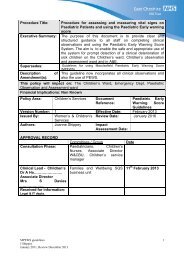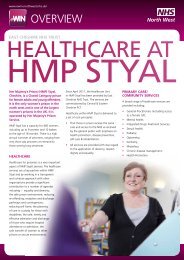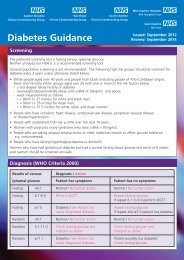The transition of young people with epilepsy from paediatric to adult ...
The transition of young people with epilepsy from paediatric to adult ...
The transition of young people with epilepsy from paediatric to adult ...
You also want an ePaper? Increase the reach of your titles
YUMPU automatically turns print PDFs into web optimized ePapers that Google loves.
Policy Title:Executive Summary:Supersedes:Description <strong>of</strong>Amendment(s):Guidelines for the <strong>transition</strong> <strong>of</strong> <strong>young</strong> <strong>people</strong> <strong>with</strong> <strong>epilepsy</strong><strong>from</strong> <strong>paediatric</strong> <strong>to</strong> <strong>adult</strong> careThis document outlines the pathway <strong>of</strong> <strong>transition</strong> forchildren <strong>with</strong> <strong>epilepsy</strong> in<strong>to</strong> the <strong>adult</strong> setting. <strong>The</strong> <strong>transition</strong>process encompasses the planning, education, nurturing,support and organisation required for the <strong>young</strong> personand their family <strong>to</strong> move on <strong>to</strong> <strong>adult</strong> services at a pacetailored <strong>to</strong> the individual child. Responsibilities and timingsfor the stages <strong>of</strong> <strong>transition</strong> are identified.No previous guidelineNo amendments necessary after the consultation periodThis policy will impact on: <strong>The</strong> Children’s unit, Multi-disciplinary team servies,Adult services.Financial Implications: Non KnownPolicy Area: Children’s Services DocumentReference:Version Number: 1 Effective Date: March 2010Issued By: Women’s & Review Date: Feb 2013Children’s ServicesAuthors: F. Skinner ImpactAssessment Date:Consultation Phase:Direc<strong>to</strong>r Women andChildren’sMr VHall…………………..Associate Direc<strong>to</strong>rMrs GHopps……………….Received forinformation:APPROVAL RECORDCommittees / GroupPaediatricians, Children’sNurses, AssociateDirec<strong>to</strong>r W&C BU, AdultNeurologist, Adult<strong>epilepsy</strong> nurse specialistDate28.1.10 – 11.2.10Guidelines for the <strong>transition</strong> <strong>of</strong> <strong>young</strong> <strong>people</strong> <strong>with</strong> <strong>epilepsy</strong> <strong>from</strong> <strong>paediatric</strong> <strong>to</strong> <strong>adult</strong> care.F. Skinner Paediatric <strong>epilepsy</strong> nurse specialist, East Cheshire NHS TrustMarch 2010, review February 2013
Guidelines for the<strong>transition</strong> <strong>of</strong> <strong>young</strong> <strong>people</strong><strong>with</strong> <strong>epilepsy</strong> <strong>from</strong><strong>paediatric</strong> <strong>to</strong> <strong>adult</strong> careSafe, Effective and Efficient Specialist Acute HealthcareChairman: Kathy CowellChief Executive: John WilbrahamGuidelines for the <strong>transition</strong> <strong>of</strong> <strong>young</strong> <strong>people</strong> <strong>with</strong> <strong>epilepsy</strong> <strong>from</strong> <strong>paediatric</strong> <strong>to</strong> <strong>adult</strong> care.F. Skinner Paediatric <strong>epilepsy</strong> nurse specialist, East Cheshire NHS TrustMarch 2010, review February 2013
IntroductionThis document outlines the pathway <strong>of</strong> <strong>transition</strong> for children <strong>with</strong> <strong>epilepsy</strong> in<strong>to</strong> the<strong>adult</strong> setting. <strong>The</strong> <strong>transition</strong> process encompasses the planning, education, nurturing,support and organisation required for the <strong>young</strong> person and their family <strong>to</strong> move on<strong>to</strong> <strong>adult</strong> services at a pace tailored <strong>to</strong> the individual child.Definition <strong>of</strong> TransitionTransition can be defined as ‘a purposeful, planned process that addresses themedical, psychosocial and educational/vocational needs <strong>of</strong> adolescents and <strong>young</strong><strong>adult</strong>s <strong>with</strong> chronic physical and medical conditions as they move <strong>from</strong> child-centred<strong>to</strong> <strong>adult</strong>-oriented health care systems (Blum et al, 1993, cited by DH/Child Health andMaternity Services, 2006).ResponsibilitiesChildren <strong>with</strong> <strong>epilepsy</strong> in this trust are cared for primarily by a <strong>paediatric</strong>ian <strong>with</strong> aspecial interest in <strong>epilepsy</strong>, and an <strong>epilepsy</strong> nurse. Referrals are made <strong>to</strong> the visiting<strong>paediatric</strong> neurologist <strong>from</strong> Manchester Children’s Hospital if this is warranted.Many <strong>of</strong> those <strong>with</strong> <strong>epilepsy</strong> have further complications, bringing them under theumbrella <strong>of</strong> ‘<strong>epilepsy</strong> plus’. <strong>The</strong>se children <strong>with</strong> more complex needs may alsowarrant the involvement <strong>of</strong>, for example, the visiting neurologist, the ChildDevelopment Centre, behavioural nurses, the CAMHs team, physiotherapists,occupational therapists, speech therapists, educational psychologists.<strong>The</strong>refore <strong>transition</strong> services are multidisciplinary. <strong>The</strong>y must be undertaken incollaboration <strong>with</strong> the <strong>young</strong> <strong>people</strong> involved and their families.When <strong>transition</strong> should begin<strong>The</strong> children <strong>with</strong> ‘straightforward <strong>epilepsy</strong>’ are transferred <strong>to</strong> <strong>adult</strong> services aged 16.Those <strong>with</strong> learning difficulties are transferred aged 19.<strong>The</strong>re are however two main stages <strong>to</strong> the <strong>transition</strong> process. For the child <strong>with</strong>straightforward <strong>epilepsy</strong> these are:<strong>The</strong> Early Stage (13-14 years)<strong>The</strong> child and their family should be introduced <strong>to</strong> the idea <strong>of</strong> <strong>transition</strong> <strong>to</strong> <strong>adult</strong> care,and the need for the <strong>young</strong> person <strong>to</strong> develop their au<strong>to</strong>nomy at the same time beingsupported by the family. <strong>The</strong> <strong>young</strong> person should become aware <strong>of</strong> their own healthneeds and care needs, and the full implications <strong>of</strong> their <strong>epilepsy</strong>. An assessment <strong>of</strong>the <strong>young</strong> person’s level <strong>of</strong> understanding is as important as providing informationand education about services available in the <strong>adult</strong> health care system. <strong>The</strong> concept<strong>of</strong> becoming a pr<strong>of</strong>essional on their own should be gradually introduced in order <strong>to</strong>give the <strong>young</strong> person and their family time <strong>to</strong> adjust <strong>to</strong> this change. <strong>The</strong> <strong>young</strong>person should practise their skills, gather information and begin <strong>to</strong> set goals forparticipating in their own care.Guidelines for the <strong>transition</strong> <strong>of</strong> <strong>young</strong> <strong>people</strong> <strong>with</strong> <strong>epilepsy</strong> <strong>from</strong> <strong>paediatric</strong> <strong>to</strong> <strong>adult</strong> care.F. Skinner Paediatric <strong>epilepsy</strong> nurse specialist, East Cheshire NHS TrustMarch 2010, review February 2013
Final Stage (15-16 years)By now the <strong>young</strong> person and their family should be feeling confident about leavingthe <strong>paediatric</strong> system, and the <strong>young</strong> person should have a considerable degree <strong>of</strong>au<strong>to</strong>nomy over their care. <strong>The</strong>y should be aware <strong>of</strong> their own healthcare needs andhow best <strong>to</strong> access support, or seek advice and further education if required.For the child <strong>with</strong> learning difficulties, the process will begin approximately two yearslater, and how much au<strong>to</strong>nomy the child can be expected <strong>to</strong> have will depend on theseverity <strong>of</strong> their difficulties.Six key areas have been identified providing the aims and subjects for discussionthroughout the <strong>transition</strong> period. <strong>The</strong>se are:-Self advocacyIndependent health care behaviourSexual healthPsycho-social supportEducational and vocational planningHealth and lifestyleAudit<strong>The</strong> guidelines will be audited in line <strong>with</strong> the KPI’s identified on an annual basis bythe <strong>epilepsy</strong> nurse specialist and reported <strong>to</strong> the clinical governance group andclinical manager and lead. Any action plans developed <strong>from</strong> this audit will be agreedby the clinical lead consultant for <strong>paediatric</strong> <strong>epilepsy</strong> <strong>with</strong> an annual review <strong>of</strong>progress.Key Performance Indica<strong>to</strong>rs1. Young <strong>people</strong> identified as requiring commencement <strong>of</strong> the <strong>transition</strong> process willhave a documented meeting <strong>with</strong> their key worker.2. Successful <strong>transition</strong> will be completed by the age <strong>of</strong> 16/19 years as appropriate <strong>to</strong>that individual child.3. Patients will feel fully prepared <strong>to</strong> move in<strong>to</strong> the <strong>adult</strong> setting by the end <strong>of</strong><strong>transition</strong>.ReferencesDH/Child Health and Maternity Services (2006) Transition: getting it right for <strong>young</strong><strong>people</strong>. Improving the <strong>transition</strong> <strong>of</strong> <strong>young</strong> <strong>people</strong> <strong>with</strong> long term conditions <strong>from</strong>children’s <strong>to</strong> <strong>adult</strong> health services. Department <strong>of</strong> Health.BibliographyRoyal College <strong>of</strong> Nursing (2004) Adolescent Transition Care. Guidance for nursingstaff.Paone, M. Youth Transition Services. British Columbia’s Children’s HospitalGuidelines for the <strong>transition</strong> <strong>of</strong> <strong>young</strong> <strong>people</strong> <strong>with</strong> <strong>epilepsy</strong> <strong>from</strong> <strong>paediatric</strong> <strong>to</strong> <strong>adult</strong> care.F. Skinner Paediatric <strong>epilepsy</strong> nurse specialist, East Cheshire NHS TrustMarch 2010, review February 2013
Interdisciplinary <strong>transition</strong> planning checklist and evidence record for:NAME:DOB:HOSP. NO:ADDRESS:CONSULTANT:NAMED NURSE:G.P:EDUCATION (SCHOOL, TEACHER, SENCO etc):SOCIAL WORKER:OTHER MULTIDISCIPLINARY MEMBERS INVOLVED:Early stage <strong>transition</strong>Start date:Final stage <strong>transition</strong>Start date:Guidelines for the <strong>transition</strong> <strong>of</strong> <strong>young</strong> <strong>people</strong> <strong>with</strong> <strong>epilepsy</strong> <strong>from</strong> <strong>paediatric</strong> <strong>to</strong> <strong>adult</strong> care.F. Skinner Paediatric <strong>epilepsy</strong> nurse specialist, East Cheshire NHS TrustMarch 2010, review February 2013
AppendixGuidelines for the <strong>transition</strong> <strong>of</strong> <strong>young</strong> <strong>people</strong> <strong>with</strong> <strong>epilepsy</strong> <strong>from</strong> <strong>paediatric</strong> <strong>to</strong> <strong>adult</strong> care.F. Skinner Paediatric <strong>epilepsy</strong> nurse specialist, East Cheshire NHS TrustMarch 2010, review February 2013
Early Stage TransitionSelf-advocacyEducate …………. in describing their health condition.Encourage …………. <strong>to</strong> ask questions.Encourage parents <strong>to</strong> participate.Action:Ensure ……….. has information leaflets relevant <strong>to</strong> condition, and encourage <strong>to</strong>discuss and describe their condition verbally.Evidence:…………. was able <strong>to</strong> give a definition <strong>of</strong> <strong>epilepsy</strong>, and describe the type <strong>of</strong> seizures….. has.Other evidence:Signatures:Date:Independent health care behavioursDiscuss the medications that are required daily.Check that ………….. understand’s issues around compliance.Ensure ………… is able <strong>to</strong> seek help/ understands the use <strong>of</strong> Medical AlertID.Action:Provide information leaflets on the specific medication.Arrange a meeting <strong>with</strong> the pharmacist if ………….. requires this.Evidence:………….. was able <strong>to</strong> identify their medication and when they take it.………….. understands what may happen if they do not take their medication.………….. is aware <strong>of</strong> informing those …… is <strong>with</strong>, about ……. condition if it isappropriate.Other evidence:Signatures:Date:Guidelines for the <strong>transition</strong> <strong>of</strong> <strong>young</strong> <strong>people</strong> <strong>with</strong> <strong>epilepsy</strong> <strong>from</strong> <strong>paediatric</strong> <strong>to</strong> <strong>adult</strong> care.F. Skinner Paediatric <strong>epilepsy</strong> nurse specialist, East Cheshire NHS TrustMarch 2010, review February 2013
Sexual healthDiscuss puberty changes, and how this can sometimes lead <strong>to</strong> an increase inseizures.Ensure ………… and their parents know where <strong>to</strong> get information aboutpuberty, sex and sexuality.Action:Provide……………. <strong>with</strong> leaflets specifically aimed at <strong>young</strong> <strong>adult</strong>s addressing sexand sexuality.For girls, provide information on the menstrual cycle and how this can sometimesaffect their <strong>epilepsy</strong>.Evidence:……………. has discussed the above issues.……………. is aware the menstrual cycle may affect her seizure frequency.Other evidence:Signatures:Date:Psychosocial supportProvide parents <strong>with</strong> the opportunity <strong>to</strong> discuss their feelings about loss <strong>of</strong>control over their child’s condition, concerns about the future and increasingthe adolescents independence.Talk <strong>to</strong> …………… about social activities, friends and supportive relationshipsthey have.Encourage .................. <strong>to</strong> join a club at school, or a social group.Action:Hold a frank discussion <strong>with</strong> …………. and his/her parents addressing these issues.Discuss how <strong>epilepsy</strong> should not be a barrier <strong>to</strong> an active social life.Evidence:................... is aware that it is important <strong>to</strong> have support <strong>from</strong> those around themthroughout their lives when possible..................... belongs <strong>to</strong> clubs/ groups.Other evidence:Signatures:Date:Guidelines for the <strong>transition</strong> <strong>of</strong> <strong>young</strong> <strong>people</strong> <strong>with</strong> <strong>epilepsy</strong> <strong>from</strong> <strong>paediatric</strong> <strong>to</strong> <strong>adult</strong> care.F. Skinner Paediatric <strong>epilepsy</strong> nurse specialist, East Cheshire NHS TrustMarch 2010, review February 2013
Educational and vocational planningTalk about what ………………’s responsibilities are at home.Discuss any restrictions, either real or imagined, that affect ……………’seducation and recreational activites.Discuss how the Connexions team can help.Talk about possible career plans and ideas.Action:Discuss the importance <strong>of</strong> taking responsibility for things, eg. chores <strong>with</strong>in the home.Discuss hobbies …………… has and ensure …………. has the sport and leisurebooklet.Ask what subjects……………. would like <strong>to</strong> take at school and if they have anythoughts on where this may lead.Discuss <strong>with</strong> the school nurse if there are any concerns in school.Ensure .................... has linked up <strong>with</strong> the Connexions team.Evidence:…………….. leads an active role <strong>with</strong>in the family.…………….. and his/her family are happy that they are receiving the support that isrequired at school, and fulfilling his/her aims and goals........................ knows who <strong>to</strong> speak <strong>to</strong> regarding career advice and has feasibleideas on their future career.Other evidence:Signatures:Date:Health and LifestyleDiscuss issues around smoking, alcohol and street drugs.Discuss what the impact <strong>of</strong> the above behaviours can mean for seizurefrequency.Action:Provide information leaflets on the above behaviours.Evidence:…………….. is able <strong>to</strong> explain what may happen if they indulge in any <strong>of</strong> the above,and what they can do <strong>to</strong> keep themselves at minimal risk.Other evidence:Signatures:Date:Guidelines for the <strong>transition</strong> <strong>of</strong> <strong>young</strong> <strong>people</strong> <strong>with</strong> <strong>epilepsy</strong> <strong>from</strong> <strong>paediatric</strong> <strong>to</strong> <strong>adult</strong> care.F. Skinner Paediatric <strong>epilepsy</strong> nurse specialist, East Cheshire NHS TrustMarch 2010, review February 2013
Final Stage TransitionSelf-advocacyExplain all the available <strong>adult</strong> care options.Provide details <strong>of</strong> the <strong>adult</strong> care providers and explain the differencesbetween <strong>paediatric</strong> and <strong>adult</strong> care.Assist ……………….. and their family in choosing <strong>adult</strong> care providers.Make sure …………… knows how <strong>to</strong> access information about their <strong>epilepsy</strong>,eg, through support groups, internet, library, <strong>epilepsy</strong> charity organisations.Action:Ensure referrals are made <strong>to</strong> the relevant care providers who will take over the care.Provide ………….. <strong>with</strong> postal addresses, web addresses, and telephone numbers <strong>of</strong>the organisations they can contact if they do not already have them.Evidence:………………. has chosen and is happy <strong>with</strong> <strong>adult</strong> care providers.………………. acknowledges the addresses, and numbers provided and understandswhat they are for.Other evidence:Signatures:Date:Independent health care behaviour……………. maintains a seizure diary <strong>to</strong> keep track <strong>of</strong> seizures, has healthinformation, can make own appointments, can obtain own medication, aware<strong>of</strong> health providers (including names and telephone numbers), and knowswhen <strong>to</strong> get emergency help.……………. meets <strong>with</strong> <strong>adult</strong> consultant/GP/ specialist nurse beforediscontinuing <strong>paediatric</strong> care.Action:Ensure ………………. has been provided <strong>with</strong> a seizure diaryDiscuss how the appointment system works.Can describe who and where <strong>to</strong> obtain repeat prescriptions <strong>from</strong>.Facilitate a meeting between ……………… and <strong>adult</strong> care givers.Evidence:……………… is visibly keeping a seizure diary.……………… has met <strong>with</strong> <strong>adult</strong> care givers......................... has obtained more medication when theirs has run out.Other Evidence:Signatures:Date:Guidelines for the <strong>transition</strong> <strong>of</strong> <strong>young</strong> <strong>people</strong> <strong>with</strong> <strong>epilepsy</strong> <strong>from</strong> <strong>paediatric</strong> <strong>to</strong> <strong>adult</strong> care.F. Skinner Paediatric <strong>epilepsy</strong> nurse specialist, East Cheshire NHS TrustMarch 2010, review February 2013
Sexual HealthDiscuss <strong>with</strong> ……………… issues surrounding sex, including sexualvulnerability.Discuss <strong>with</strong> ........................ issues surrounding contraception, effects <strong>of</strong>medication on the unborn baby.Action:Arrange a meeting <strong>with</strong> ....................... on an individual basis if required.Provide written information on sexual health, and on drug interactions <strong>with</strong>contraceptives, and risks during pregnancy.Evidence:…………….. has participated in a conversation on sexual health....................... is able <strong>to</strong> discuss their medication and its interactions <strong>with</strong> othermedications/ during pregnancy.Other Evidence:Signatures:Date:Psycho-social supportEncourage ………………… and their parents <strong>to</strong> set positive goals.Identify if there are any issues <strong>with</strong> regard <strong>to</strong> moving away <strong>from</strong> home.Ensure ………………. is comfortable in dealing <strong>with</strong> all safety issues arising<strong>from</strong> the nature <strong>of</strong> their condition.Action:Discuss <strong>with</strong> ……………… if he/she is happy <strong>with</strong> the level <strong>of</strong> support they have.Ensure ………………. has written information on safety issues.Evidence:………………… has a supportive network <strong>of</strong> friends and family.Other evidence:Signatures:Date:Guidelines for the <strong>transition</strong> <strong>of</strong> <strong>young</strong> <strong>people</strong> <strong>with</strong> <strong>epilepsy</strong> <strong>from</strong> <strong>paediatric</strong> <strong>to</strong> <strong>adult</strong> care.F. Skinner Paediatric <strong>epilepsy</strong> nurse specialist, East Cheshire NHS TrustMarch 2010, review February 2013
Educational and vocational planningDiscuss employment options- what kind <strong>of</strong> work does …………….. want <strong>to</strong>do? Are there any restrictions?Discuss the Disability Discrimination Act and how it affects employers etc.Discuss the implications if ………………….. wishes <strong>to</strong> go <strong>to</strong> college.Action:Discuss employment ideas and inform ………………… <strong>of</strong> any potential problems <strong>with</strong>this.Provide written information on the Disability Discrimination Act.Reiterate safety issues <strong>with</strong> regard <strong>to</strong> lifestyle at college.Evidence:…………………. is able <strong>to</strong> apply for jobs, courses that he/she wishes <strong>to</strong>o, knowingthe limitations <strong>of</strong> his/her condition.Other Evidence:Signatures:Date:Health and LifestyleGive ………………. opportunities <strong>to</strong> discuss feelings <strong>of</strong> low mood, feelings <strong>of</strong>depression or suicidal thoughts.Ask ……………… who they would contact for help and advice if they sufferthe above problems.Discuss plans for driving, ensure ............................ understands the rules andconditions.Action:Provide information booklet on rules for driving/ seizures.Provide helpline numbers.Evidence:……………….. can produce name and numbers for those he/she would contact ifneeded........................... is able <strong>to</strong> explain the rules around driving and obtaining a licence.Other Evidence:Signatures:Date:Guidelines for the <strong>transition</strong> <strong>of</strong> <strong>young</strong> <strong>people</strong> <strong>with</strong> <strong>epilepsy</strong> <strong>from</strong> <strong>paediatric</strong> <strong>to</strong> <strong>adult</strong> care.F. Skinner Paediatric <strong>epilepsy</strong> nurse specialist, East Cheshire NHS TrustMarch 2010, review February 2013
Appendix 2 –Equality and Human Rights Policy Screening ToolPolicy Title: Guidelines for the <strong>transition</strong> <strong>of</strong> <strong>young</strong> <strong>people</strong><strong>with</strong> <strong>epilepsy</strong> <strong>from</strong> <strong>paediatric</strong> <strong>to</strong> <strong>adult</strong> careDirec<strong>to</strong>rate: Women & Children’sbusiness unitName <strong>of</strong> person/s auditing / authoring policy: Felicity Skinner – Paediatric Epilepsy SpecialistNursePolicy Content:For each <strong>of</strong> the following check whether the policy under consideration is sensitive <strong>to</strong> <strong>people</strong> <strong>of</strong> a different age,ethnicity, gender, disability, religion or belief, and sexual orientation?<strong>The</strong> checklist below will help you <strong>to</strong> identify any strengths and weaknesses <strong>of</strong> the policy and <strong>to</strong> check whether it iscompliant <strong>with</strong> equality legislation.1. Check for DIRECT discrimination against any minority group <strong>of</strong> PATIENTS:Question: Does the policy contain any statements whichmay disadvantage <strong>people</strong> <strong>from</strong> the following groups?ResponseActionrequiredResourceimplicationYes No Yes No Yes No1.0 Age? X1.1 Gender (Male, Female and Transsexual)? X1.2 Learning Difficulties / Disability or Cognitive Impairment? X1.3 Mental Health Need? X1.4 Sensory Impairment? X1.5 Physical Disability? X1.6 Race or Ethnicity? X1.7 Religious Belief? X1.8 Sexual Orientation? X2. Check for DIRECT discrimination against any minority group relating <strong>to</strong> EMPLOYEES:Question: Does the policy contain any statements whichmay disadvantage employees or potential employees<strong>from</strong> any <strong>of</strong> the following groups?ResponseActionrequiredResourceimplicationYes No Yes No Yes No2.0 Age? X2.1 Gender (Male, Female and Transsexual)? X2.2 Learning Difficulties / Disability or Cognitive Impairment? X2.3 Mental Health Need? X2.4 Sensory Impairment? X2.5 Physical Disability? X2.6 Race or Ethnicity? X2.7 Religious Belief? X2.8 Sexual Orientation? XTOTAL NUMBER OF ITEMS ANSWERED ‘YES’ INDICATING DIRECT DISCRIMINATION = 0Guidelines for the <strong>transition</strong> <strong>of</strong> <strong>young</strong> <strong>people</strong> <strong>with</strong> <strong>epilepsy</strong> <strong>from</strong> <strong>paediatric</strong> <strong>to</strong> <strong>adult</strong> care.F. Skinner Paediatric <strong>epilepsy</strong> nurse specialist, East Cheshire NHS TrustMarch 2010, review February 2013


